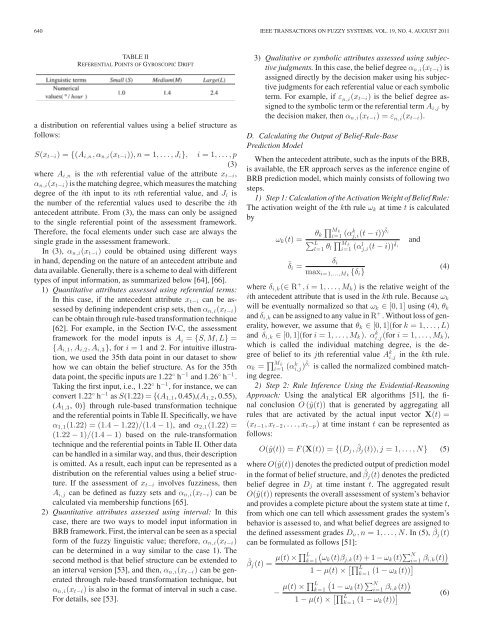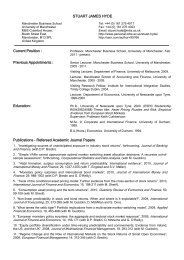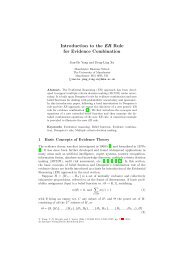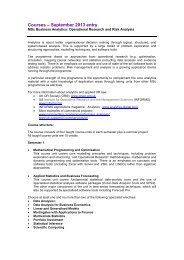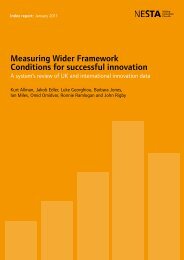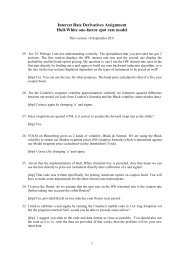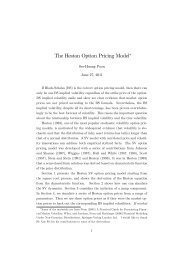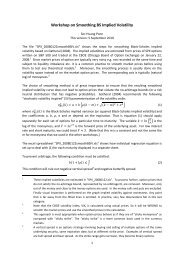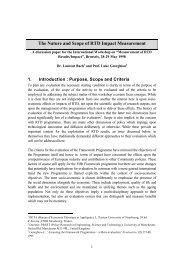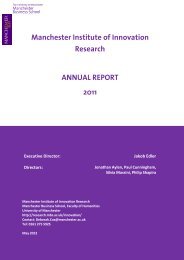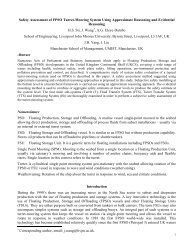A New Prediction Model Based on Belief Rule Base for System's ...
A New Prediction Model Based on Belief Rule Base for System's ...
A New Prediction Model Based on Belief Rule Base for System's ...
You also want an ePaper? Increase the reach of your titles
YUMPU automatically turns print PDFs into web optimized ePapers that Google loves.
640 IEEE TRANSACTIONS ON FUZZY SYSTEMS, VOL. 19, NO. 4, AUGUST 2011TABLE IIREFERENTIAL POINTS OF GYROSCOPIC DRIFTa distributi<strong>on</strong> <strong>on</strong> referential values using a belief structure asfollows:S(x t−i )={(A i,n ,α n,i (x t−i )),n=1,...,J i }, i =1,...,p(3)where A i,n is the nth referential value of the attribute x t−i ,α n,i (x t−i ) is the matching degree, which measures the matchingdegree of the ith input to its nth referential value, and J i isthe number of the referential values used to describe the ithantecedent attribute. From (3), the mass can <strong>on</strong>ly be assignedto the single referential point of the assessment framework.There<strong>for</strong>e, the focal elements under such case are always thesingle grade in the assessment framework.In (3), α n,i (x t−i ) could be obtained using different waysin hand, depending <strong>on</strong> the nature of an antecedent attribute anddata available. Generally, there is a scheme to deal with differenttypes of input in<strong>for</strong>mati<strong>on</strong>, as summarized below [64], [66].1) Quantitative attributes assessed using referential terms:In this case, if the antecedent attribute x t−i can be assessedby defining independent crisp sets, then α n,i (x t−i )can be obtain through rule-based trans<strong>for</strong>mati<strong>on</strong> technique[62]. For example, in the Secti<strong>on</strong> IV-C, the assessmentframework <strong>for</strong> the model inputs is A i = {S, M, L} ={A i,1 ,A i,2 ,A i,3 },<strong>for</strong>i =1and 2. For intuitive illustrati<strong>on</strong>,we used the 35th data point in our dataset to showhow we can obtain the belief structure. As <strong>for</strong> the 35thdata point, the specific inputs are 1.22 ◦ h −1 and 1.26 ◦ h −1 .Taking the first input, i.e., 1.22 ◦ h −1 , <strong>for</strong> instance, we canc<strong>on</strong>vert 1.22 ◦ h −1 as S(1.22) = {(A 1,1 , 0.45),(A 1,2 , 0.55),(A 1,3 ,0)} through rule-based trans<strong>for</strong>mati<strong>on</strong> techniqueand the referential points in Table II. Specifically, we haveα 1,1 (1.22) = (1.4 − 1.22)/(1.4 − 1), and α 2,1 (1.22) =(1.22 − 1)/(1.4 − 1) based <strong>on</strong> the rule-trans<strong>for</strong>mati<strong>on</strong>technique and the referential points in Table II. Other datacan be handled in a similar way, and thus, their descripti<strong>on</strong>is omitted. As a result, each input can be represented as adistributi<strong>on</strong> <strong>on</strong> the referential values using a belief structure.If the assessment of x t−i involves fuzziness, thenA i,j can be defined as fuzzy sets and α n,i (x t−i ) can becalculated via membership functi<strong>on</strong>s [65].2) Quantitative attributes assessed using interval: In thiscase, there are two ways to model input in<strong>for</strong>mati<strong>on</strong> inBRB framework. First, the interval can be seen as a special<strong>for</strong>m of the fuzzy linguistic value; there<strong>for</strong>e, α n,i (x t−i )can be determined in a way similar to the case 1). Thesec<strong>on</strong>d method is that belief structure can be extended toan interval versi<strong>on</strong> [53], and then, α n,i (x t−i ) can be generatedthrough rule-based trans<strong>for</strong>mati<strong>on</strong> technique, butα n,i (x t−i ) is also in the <strong>for</strong>mat of interval in such a case.For details, see [53].3) Qualitative or symbolic attributes assessed using subjectivejudgments. In this case, the belief degree α n,i (x t−i ) isassigned directly by the decisi<strong>on</strong> maker using his subjectivejudgments <strong>for</strong> each referential value or each symbolicterm. For example, if ε n,i (x t−i ) is the belief degree assignedto the symbolic term or the referential term A i,j bythe decisi<strong>on</strong> maker, then α n,i (x t−i )=ε n,i (x t−i ).D. Calculating the Output of <strong>Belief</strong>-<strong>Rule</strong>-<strong>Base</strong><str<strong>on</strong>g>Predicti<strong>on</strong></str<strong>on</strong>g> <str<strong>on</strong>g>Model</str<strong>on</strong>g>When the antecedent attribute, such as the inputs of the BRB,is available, the ER approach serves as the inference engine ofBRB predicti<strong>on</strong> model, which mainly c<strong>on</strong>sists of following twosteps.1) Step 1: Calculati<strong>on</strong> of the Activati<strong>on</strong> Weight of <strong>Belief</strong> <strong>Rule</strong>:The activati<strong>on</strong> weight of the kth rule ω k at time t is calculatedby∏θ M k k i=1ω k (t) =(αk j,i (t − i))¯δ i∑ Ll=1 θ ∏ M kl i=1 (αl j,i (t − andi))¯δ iδ i¯δ i =(4)max i=1,...,Mk {δ i }where δ i,k (∈ R + ,i=1,...,M k ) is the relative weight of theith antecedent attribute that is used in the kth rule. Because ω kwill be eventually normalized so that ω k ∈ [0, 1] using (4), θ kand δ i,k can be assigned to any value in R + . Without loss of generality,however, we assume that θ k ∈ [0, 1](<strong>for</strong> k =1,...,L)and δ i,k ∈ [0, 1](<strong>for</strong> i =1,...,M k ). αi,j k (<strong>for</strong> i =1,...,M k ),which is called the individual matching degree, is the degreeof belief to its jth referential value A k i,j in the kth rule.α k = ∏ M ki=1 (αk i,j )¯δ iis called the normalized combined matchingdegree.2) Step 2: <strong>Rule</strong> Inference Using the Evidential-Reas<strong>on</strong>ingApproach: Using the analytical ER algorithms [51], the finalc<strong>on</strong>clusi<strong>on</strong> O (ŷ(t)) that is generated by aggregating allrules that are activated by the actual input vector X(t) =(x t−1 ,x t−2 ,...,x t−p ) at time instant t can be represented asfollows:O(ŷ(t)) = F (X(t)) = {(D j , ˆβ j (t)),j =1,...,N} (5)where O(ŷ(t)) denotes the predicted output of predicti<strong>on</strong> modelin the <strong>for</strong>mat of belief structure, and ˆβ j (t) denotes the predictedbelief degree in D j at time instant t. The aggregated resultO(ŷ(t)) represents the overall assessment of system’s behaviorand provides a complete picture about the system state at time t,from which <strong>on</strong>e can tell which assessment grades the system’sbehavior is assessed to, and what belief degrees are assigned tothe defined assessment grades D n ,n=1,...,N.In(5), ˆβ j (t)can be <strong>for</strong>mulated as follows [51]:ˆβ j (t) = μ(t) × ∏ L(k=1 ωk (t)β j,k (t)+1− ω k (t) ∑ Ni=1 β i,k(t) )1 − μ(t) × [∏ Lk=1 (1 − ω k (t)) ]− μ(t) × ∏ Lk=1(1 − ωk (t) ∑ Ni=1 β i,k(t) )1 − μ(t) × [∏ Lk=1 (1 − ω k (t)) ] (6)


